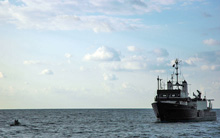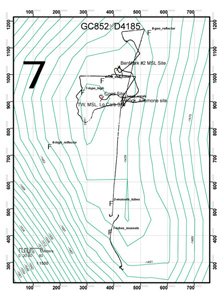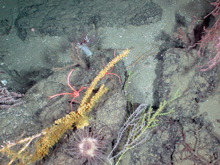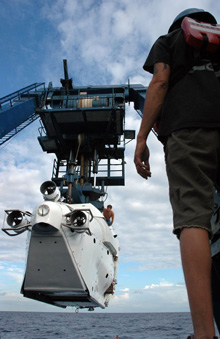
The research vessel (R/V) Atlantis crew shuttles additional members of the science party to the ship from the R/V Gyre. Click image for larger view and image credit.
Just after starting the ride back to the surface, the deep submergence vessel (DSV) Alvin captured this image of the elusive coral garden with the downward-looking still camera. Click image for larger view and image credit.
The Elusive Coral Garden
May 21, 2006
Cheryl Morrison
U.S. Geological Survey
27° 06.36 N
91°09.96 W
A week ago, I was keeping up with the progress of this cruise on the Web when an Chuck Fisher e-mailed, saying there was an unexpected vacancy onboard. That kicked off my scramble to make it out to the research vessel (R/V) Atlantis — in only a few days! After many e-mails, favors from friends, and plane and car rides, I finally arrived in Port Fourchon, Louisiana, to hitch a ride on the R/V Gyre. The Gyre would drop me off at the Atlantis en route to its final destination in Brazil. When I reached Port Fourchon, I quickly realized that an important detail was still missing: where, exactly, in this very large port, do I meet the Gyre? After some hasty detective work, I ffound a security guard who recalled seeing the vessel that morning.
Busy with all of the other details associated with preparing for a cruise, I hadn’t stopped to think, or ask, how long it would take the Gyre to reach the Atlantis. I expected maybe a few hours, but when I stepped onboard the Gyre, I realized we actually had an overnight voyage ahead. Early the next morning, I awoke to a welcome sight: a beautiful sunrise and the Atlantis, visible off the bow. It was an exciting transfer on a small zodiac filled with four people, gear, and packages to deliver. The seas looked a lot rougher from the zodiac than from the Gyre, especially when trying to grab the pitching rope ladder to board the Atlantis!
My involvement with Expedition to the Deep Slope project started a few months ago when a few of the pictures taken with a remote camera system on a survey cruise at the Green Canyon 852 site showed several deep corals. I’ve been working with corals for several years, but we didn’t expect to find them in abundance at these depths in the Gulf of Mexico. I arrived at the Atlantis just in time for work to begin at this site in Green Canyon and just in time for my first Alvin dive. We had maps and coordinates on hand for where the coral area was supposed to be, but no one had ever visited the coral site before.

This map shows the deep submergence vehicle DSV Alvin's dive track along the sea floor. The dive starts at the bottom of the image and heads north, towards the top. You can see how Alvin had earlier circled the mound on which researchers later discovered corals. The black line ends on top of the coral mound, where Alvin left the sea floor and started the ascent back to the surface. Click image for larger view and image credit.
Our first dive task was to attach some floats to a time-lapse camera (deployed during a previous dive), and to send it on its way to the surface. We then headed north in search of the corals. We passed over vast expanses of sediment with only a few signs of life: crab burrows, a few red shrimp, and a few mussel shells. We found one small rocky seep area close to our target, where there were supposed to be corals. Though that is great information for the others in the science crew, it’s not particularly exciting for someone focusing on corals. We moved on to our second, then third possible coral targets with similar luck. We saw a lot of mud. We searched around a high ridge and continued north on the assumption that our maps were incorrect and hoping that they were simply “offset” by a small distance in this direction.
As you can already tell, searching for an area that you have never visited and know little about is extremely difficult. It’s a particularly onerous task 1,410 m below the surface of the ocean, with limited time on bottom, and only about 10 m of visibility in any direction. It’s quite amazing how you can be almost right on top of what you’re looking for an never see it. We kept searching. . . .
One giant isopod, Bathynomus sp., and lots of mud later, we did a U-turn. We collected a few samples from seep sites that we passed on the way back. As soon as we made it to the high ridge, pilot Mark Spear told us that battery power was running low. We had to surface. He radioed the R/V Atlantis for permission to leave the bottom. We crept along as we waited for a response. Suddenly, large, beautiful bamboo coral on the top of a large carbonate rock materialized out the gloom! We were able to collect the coral quickly, just as the response from Atlantis came through. We let go of the weights and slowly started our ride to the surface. As we flew over the area, the last sights were large boulders as far as we could see with many huge soft corals growing in all directions. We had finally found our coral garden in the vast expanse of barren landscape, but didn’t have time to explore it today. Later review of our dive tracks confirmed that we had circled the site earlier in the dive, missing it by a mere tens of meters. At least the next dives will be better informed, and we will have more time to explore the coral community!
Sign up for the Ocean Explorer E-mail Update List.






























